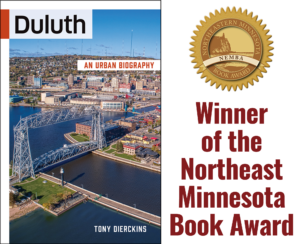The Townsites that Became Duluth (1856–1857)

The Head of the Lakes, 1856. {Map: Zenith City Press]
Many of these newcomers had their eyes on land across the bay and along the North Shore, where they hoped to become wealthy operating copper mines. Some couldn’t wait for the signing of the second Treaty of La Pointe. One group, including Robert McLean, August Zachau, and Vose Palmer, quietly slipped out of Superior in a sailboat in the dead of night and made their way to the North Shore. There they began building a log cabin, but the effort came to a halt when those handling the axes refused to work until they were fed—an action McLean described as “the first labor strike at the Head of the Lakes.” They never finished the cabin, but as soon as the treaty allowed, those would-be preemptors and many others swarmed the lake’s Minnesota side, making legitimate claims and platting townsites, many of which would later form the City of Duluth.
Between today’s Fortieth and Forty-Third Avenues East in Duluth, from the lakeshore to McCullough Street, James Bell platted the townsite of Bellville, but except for his cabin—which at least one historian believes was the same building started by Zachau and his friends in 1854—it remained unoccupied until the 1870s. Oregon and Chester Creeks (essentially Twenty-First and Fifteenth Avenues East) provided the borders for Capt. James A. Markland’s townsite of Endion (Ojibwe for “my, your, or his home”), which stretched from the lake shore to about Fourth Street. West of Endion, the townsite of Portland covered the ground between Chester Creek and Third Avenue East from the lake to roughly Fifth Street. Its founders, including James D. Ray and Clinton Markell, hailed from Ashtabula, Ohio.
The newcomers established several townsites west of Portland in today’s downtown Duluth, from roughly Fifth Street to Oatka (Ojibwe for “an opening”) Beach on Minnesota Point near today’s South Thirty-Eighth Street. George and William Nettleton, Joshua B. Culver, Orrin Rice, and Robert Jefferson staked out a townsite between Third Avenue East and Eighth Avenue West at the base of Point of Rocks, from First Street south to just above Buchanan Street in today’s Canal Park business district. The Nettletons hosted a picnic on Minnesota Point in June 1856, asking their neighbors to suggest a name for their new town. After Reverend J. G. Smith regaled his fellow picnickers with heroic stories of Daniel Greysolon, Sieur du Lhut, they enthusiastically approved his anglicized suggestion of “Duluth.” They anointed the choice with a champagne toast, confident their new town would become the “Queen of the West.”
Directly above Duluth to Fifth Street John Pendergrast platted North Duluth, then lost nearly all of it in a dispute with the Nettletons. Immediately below Duluth to roughly today’s ship canal William Cowell purchased property called Cowell’s Addition, and south of that, all the way to Oatka, Markland and Robert Reed platted Middleton. Meanwhile C. P. Huestis and C. A. Post platted Fremont among the muck and floating islands below modern Michigan Street between Minnesota Point and Point of Rocks.
Those borders blurred in 1857, when the communities centered on and above Minnesota Point—including everything from Fifth Street to Oatka between Third Avenue East and Eight Avenue West—incorporated together as the town of Duluth.

The townsites centered on Minnesota Point in 1856 (left) and 1857 (right). [Map: Zenith City Press]
A group composed mainly of Methodists established a townsite west of Rice’s Point. They included Reverend Edmund Ely, a Massachusetts native and no stranger to the region. In the 1830s he had established a Protestant mission adjacent to the fur post at Fond du Lac, serving until 1839. Like many missionaries and traders, he was well positioned to join the land rush. He and his wife, Mary, returned to the Head of the Lakes after Minnesota was opened to whites. Ely convinced lumber mill engineer Henry Wheeler, a New Yorker working in St. Anthony Falls (later part of Minneapolis), to move to the Head of the Lakes and establish a sawmill at the townsite Ely had staked out near Forty-Second Avenue West. Ely also convinced another Methodist minister, James Peet, to join them. Nearby, Lewis Merritt and his son Napoleon—devout Methodists from Ashtabula—put in stakes of their own. Finding themselves like-minded and linked by religion, the Elys, Wheelers, Peets, Merritts, and others combined their claims and called their village Oneota, Ojibwe for “rock from which the people sprang.” It stretched back from the bay to about Grand Avenue (which follows the same path as Third Street) roughly between Thirty-Third and Forty-Sixth Avenues West.
The land between Oneota and Fond du Lac remained undeveloped until the late 1880s. In the 1850s Fond du Lac was already home to many Ojibwe-and-French families who had remained after the fur post and mission closed, including that of Francis Roussain. Roussain—along with traders Rueben Carlton, Alexander Paul, George Morrison, and Joshua B. Culver—made it a village in 1856.
While these towns would eventually come together, evolving and expanding into today’s Duluth, initially each hoped to be the center of a great city fueled by copper mining. But the copper rush proved to be a bust, and by the time the townsites of future Duluth were established, the North Shore prospectors had all but given up their dreams of cupric fortunes.










